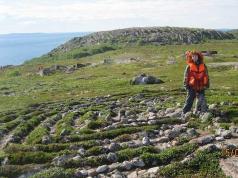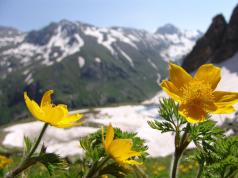Not far from Kislovodsk, in the valley of the small mountain river Alikonovka (the old name of the tract is Orekhovye Otvershki), there is a unique natural complex - Honey Falls. Here, among the mountain gorges, there is a whole group of waterfalls, the highest of which drops a stream of water from a height of 18 meters.
There are three versions explaining the origin of the name “Honey”. Firstly, they were named so because of the honey herbs blooming along the banks, secondly, there used to be a great variety of wild bees here, which died in the cold winter. But tourists most like the third version, the most romantic - this place, due to its beauty, was chosen by many newlyweds for their honeymoon.
And the place here is really very beautiful. Dolomite slopes rise to the right, and to the left are areas of rocks overgrown with grasses and thick hazel. Among the lush greenery, transparent streams of a mountain river cascade down from high ledges. Through the bright daytime sun, breaking into thousands of drops and hitting the rocks, a sheet of water turns sunlight into seven colors of the rainbow. In winter, the rapid stream freezes, and icicles hang like fringes all the way to the ground.
Baduk Lakes
The Baduk Lakes are a cascade of three mountain lakes located along the Baduk River in the Teberda Nature Reserve. These lakes are also called the Lower Baduk Lakes, and among the local population - Baduki for short. The lakes are beautiful in their beauty, surrounded by pine and birch forests. There are hiking trails around the lakes.
The first Baduk lake is the lowest along the river and also the smallest, its depth does not reach even five meters. After 260 meters there is the Second Lake, and after 60 the third: the largest and highest. The third lake is up to 9 meters deep and lies at an altitude of almost 2 thousand meters.
What sights of Karachay-Cherkessia did you like? Next to the photo there are icons, by clicking on which you can rate a particular place.
Sofia waterfalls
Sofia Falls is the source of the Sofia River, one of the five rivers that form the river called Bolshoi Zelenchuk. It is from here that not only the entire flat part of Karachay-Cherkessia, but also the arid Stavropol region is fed with water from mountain rivers. Tons of water fall from a hundred-meter height, from the mighty Sofia glacier into the valley of the same name, with noise and roar, carrying large and small stones with it, calming down only far below, crashing on the green plain. The glacier feeding the waterfalls is located in a vast square under the very top of Mount Sofia, at an altitude of 3637 meters above sea level. Sofia waterfalls are the largest in Arkhyz. They are called pulsating - the flow of water in them is inconsistent, their peak occurs during the flood period of July-August, the time of greatest melting of snow in the mountains.
The Sentinsky Temple is a dilapidated abandoned Christian church, erected at the beginning of the 10th century. It is located on a hill on the left bank of the Teberda River in the Karachay region of the Karachay-Cherkess Republic. The building, built from sand blocks, is about eight meters long and about ten meters high. Elements of images painted in the 11th century have been preserved on the walls. Nearby is a stone necropolis, probably built for the burial of priests.
Since there was an Orthodox monastery near the temple in the 19th century, the monks supported the Sentinsky temple and were engaged in its reconstruction. During Soviet rule, the monastery was destroyed.
Mount Erzog
The peak of Mount Ertsog has a height of 3683 meters and is located in the western section of the Teberdinsky ridge. The name of this mountain comes from the Abkhaz word “Eruakhz”. According to legend, here once upon a time, a long time ago, a ship ran into a large stone and crashed.
This mountain of unusual beauty goes around the southwestern side of the Alibek River valley. The top of Mount Ertsog is so inspiring with its beauty that even Yuri Vizbor, who visited Dombay quite often, mentioned this unique and extraordinary miracle of nature in his song “Dombay Waltz”.
Dombai glade
Dombayskaya Polyana is a mountainous area that is located in Karachay-Cherkessia in Kuban in the North Caucasus of Russia. The southern border is the main Caucasus range. Its highest point is the peak of Dombay-Ulgen with a height of 4046 meters.
The connection of three main gorges - Amanauz, Alibek and Dombay-Ulgen forms the natural center of the territory - the Dombay glade, located at an altitude of 1650 meters above sea level.
The borders of Dombay do not have strict boundary designations. This is the modern name of the upper part of the Teberda River, uniting several mountain gorges.
The word "dombai" is translated from the Karachay language as "bison". Previously, large herds of these mighty giants lived in the Dombay forests. There is another version according to which the Dombay glade was named after the hunter Dommai, who, catching up with the aurochs, was able to kill the beast, but could not resist and fell from the mountain into the abyss and died.
Dombay today is one of the modern sports recreation centers.
Sofiyskaya Polyana
The middle part of the Sofia Valley is a narrow gorge, squeezed by the spurs of the Cheget-Chat and Sofia ridges. From here you can climb to the valley of the Gammesh-Chat river. In the upper part the valley widens again. There is a farm, sheep sheds and a tent camp, the so-called. Sofia glade. From this part of the valley you can climb to the Sofia Saddle pass, to the Ak-Ayry and Kashkha-Erikchat valleys.
This place is called the Sofia Shelter. Once upon a time there were houses used by organized tourists for accommodation. In the nineties they were dismantled for firewood. It usually starts snowing here in May.
From the shelter the valley begins to expand. Soon a farm appears (it should not be confused with the so-called Glacier Farm - a clearing under the Sofia Saddle pass. In this clearing, there was once a farm demolished by an avalanche), from which you can see the Ak-Ayra valley with waterfalls, the Sofia Glacier with waterfalls, Sophia Saddle pass. To ascend to the Ak-Ayra valley, you need to wade through Sofia above the farm, where the road descends to the river, and the river forms several branches. The “Sofia Polyana” tent camp is located slightly above this place.
Face of Christ on Mount Mitseshta
The face of Christ in Arkhyz. This icon is quite well hidden on the slope of the Matseshta ridge; various legends have been circulating about this Savior Not Made by Hands for many centuries. The image of Christ the Savior looks at the other bank of the river, at the middle temple, with which the painting of this icon is associated. Also, the Rock Face of Christ the Savior is possible that the appearance of the face coincides with the appearance of the Alan Diocese. Local old-timers say that several hundred years ago lightning struck the rock, breaking off a huge stone, and on the remaining part of the rock, on its steep part, the face of Christ the Savior was formed. According to another version, the image of Christ was created to protect the city from the plague epidemic that broke out in these places in the 14th century. Until now, no consensus has been reached on the appearance of this icon, but pilgrims from all over the world continue to flock to it.
"Heart of the Mountains" DOMBAY. Karachaevo - Cherkessia..Dombay (Dombayskaya Polyana) is a mountainous area in Karachay-Cherkessia in the Teberda basin in the North Caucasus (Russia). From here, in a straight line, 65 km to the top of Elbrus and 65 km to the Black Sea coast. The southern border of Dombay is the Main Caucasus Range. Dombay is called the “heart of the mountains”. It is surrounded by mountains covered with coniferous forests, mainly fir. Dark coniferous forests and emerald green alpine meadows, wild rivers, waterfalls, eternal snow and glaciers create the unique beauty of this area. Mountains surround the Dombay glade on all sides.


Alpine meadows in the upper reaches of the Baduk River Baduk Lakes

The word “dombai” (dommai) means “bison” in Karachay; once upon a time, entire herds of mighty giants roamed the Dombay forests. The name of the highest mountain in this area, Dombay-Yolgen, in the language of the original inhabitants of these places means “killed bison.” There is another version, according to which the Dombay glade was named after a hunter named Dommai, who, while chasing aurochs, killed the beast, but could not resist, fell from a high mountain into the abyss and was killed...


The highest peak - Mount Dombay-Ulgen (Killed bison, 4046 m) is covered with eternal snow and glaciers. On the opposite side of the Dombai glade rises the tetrahedral peak of the Belaly-Kaya rock (Striped Mountain, 3861 m), surrounded by wide light veins of quartz; left - Black Tooth Sofrudju (Watershed). In the depths of the gorge the formidable walls of Amanauz are visible. In the foreground is the multi-headed ridge of Dzhuguturlu-Chata (Abode of Turs), the pointed peak of Ine (Needle).


Dombay is one of the modern centers of recreation and sports, a mountaineering, skiing and tourist Mecca of the Greater Caucasus. The capacity of the existing ski slopes in Dombay allows serving up to 200 thousand people per year. The ski area is located at an altitude of 1800-3200 m, the length of trails of varying degrees of difficulty is more than 20 km, the maximum elevation difference is 1400 m.








The descent from the top of the Mussa-Achitara ridge can be carried out along a dozen route options of varying degrees of steepness, difficulty and speed, which allows you to satisfy the tastes of both experienced and beginner skiers. In the vicinity of Dombay there are excellent opportunities for off-piste skiing.




In summer, Dombay is no less interesting than during the skiing season. From the clearing there are a large number of excursion routes through the territory of the Teberda Nature Reserve to the majestic natural monuments included in the UNESCO World Heritage List.




Hiking and Nordic walking are popular in Dombay; you can also rent a mountain bike, rent an all-terrain vehicle with a driver, or go on horseback along the route. There is also a deltadrome...






In summer, from the Dombai meadow you can go to the Chukhchursky waterfall (Little waterfall), roaring near the entrance to the Ptysh River gorge. The Chukhchur stream, breaking through a deep channel, roars down in powerful cascades from ledge to ledge and, having reached the valley, rushes madly towards the nearby Ptysh. Having merged, Chukhchur (Chuchkhur) and Ptysh form the Dombay-Ulgen River. The waterfall offers a wonderful view of the peaks and glaciers of the Main Range, which are not visible from the Dombai Valley.
Sofrudzhu waterfall in Karachay-Cherkessia

In the depths of the harsh gorge of the stormy Amanauz River, from a glacial grotto that you will not see even in a science fiction film (fairy tale), the Sofrudzhuk waterfall (Sofrudzhinsky) collapses from a height of several tens of meters. The waterfall itself is a spectacle that amazes its viewer with its grandeur. Having escaped from the glacial grotto, a high-water stream with noise and roar falls into the gorge from a height of several tens of meters, scattering diamond splashes around. The mighty power of the waterfall and its wild beauty make a great impression.


One of the largest waterfalls on the territory of the Teberdinsky Nature Reserve is located deep in the harsh gorge of the Amanauz River, which means “evil mouth” in translation.

River Sulahat


Dombay (Karach-Balk. Dommai) - urban-type settlement (resort village).
Located at an altitude of 1650 m in the intermountain basin (Dombay glade) at the northern foot of the Main Caucasus Range, at the confluence of the Alibek and Dombay-Ulgen rivers into Amanauz - one of the sources of the Teberda River. The distance to the administrative center of the republic is 108 km. The distance to the nearest railway station is 101 km.



A flying saucer that landed here:

In fact, this is the famous hotel called "The Plate", which can be entered through a camouflaged hinged hatch. There are double rooms, 1 room for 4 people, a kitchen, shower room and toilet. Hotel "Tarelka" first welcomed its guests back in 1979. Perhaps this is the most amazing and unusual hotel in the Dombay mountains. Being at an altitude of 2,250 meters above sea level, you can feel like aliens from distant planets who are discovering a new, amazing world of the Caucasus Mountains.
Alibek waterfall
One of the largest and most spectacular waterfalls in Dombay. The height of the waterfall is more than 25 meters. The waterfall is formed by the fall of the Dzhalovchatka river from the Alibek glacier; The stones from which water falls are called “ram’s foreheads.” Alibek waterfall appeared in the 20th century. A popular object of hiking tourism. Located on the territory of the Teberda Nature Reserve.
Baduk Lakes - a cascade of three mountain lakes on the Baduk River, the left tributary of the Teberda

Due to the fact that there are other lakes higher up the Baduk River (less known and visited), these three lakes are also called the Lower Baduk Lakes. Research has shown that these are lakes of landslide-dammed origin, and their age does not exceed 150-200 years.


Around the lakes there are pine forests and birch forests. The lakes are famous for their picturesqueness and are one of the natural attractions of the Teberda Nature Reserve, on whose territory they are located.

Third Baduk Lake
The highest (1990 meters), the westernmost and the largest of the three, its area is 3.6 hectares, its maximum length is about 330 meters, and its width is 200 meters. The length of the coastline is 0.9 km. Depth - up to 9 meters. Sometimes it is called Great Baduk Lake. The bluish-green water in it warms up to 10 °C in summer. There are trout.



Teberdinsky Reserve

The Teberdinsky Reserve is located within the Karachay, Zelenchuksky and Urupsky districts of the Karachay-Cherkess Republic. The area of the reserve is 85,064 hectares. Located on the northern slopes of the Main Caucasus Range. It consists of two sections: Teberda and Arkhyz.









There are 157 lakes in the reserve. The Baduk Lakes, in particular, are famous for their beauty. The maximum depth of the lakes is 30-50 m. Almost all lakes are located at altitudes above 2000 m. Many lakes are difficult to access. Most of them arose when glaciers melted. The age of the lakes is 200-1000 years, with the exception of Lake Karakol in the city of Teberda, which arose during the retreat of the ancient Teberda glacier approximately 8000-10000 years ago. Almost everywhere you can hear the murmur of mountain rivers, streams or the sound of waterfalls. The rivers in the reserve are fed by snow and glaciers. There are 30 of them in total.

Lake under the Khrustalny pass in the Khuty valley, a tributary of the Teberda.









Teberda River
Teberda (Karach-Balk. Teberdi) is a river in the North Caucasus in Karachay-Cherkessia, a left tributary of the Kuban. The Russian name of the river comes from the Karachay Te(y)berdi according to a record from the first half of the 19th century.

There are several translation options for this toponym. According to one of them, Teberda (Teberdi) in Karachay means “eviselok” (literally “pushed out”). Separate settlement villages in the valley apparently existed back in the 16th-17th centuries, which is where this name came from.


It is possible that the word “Teberda” could come from “tab jerdi”, which translated from Karachay means “convenient place”. There is another interpretation: the origin of the name is found in the words “teyri berdi”, which means “gift of God” (literally “god gave”).

Along the Murudzhinsky lakes. Dombay
The famous Murudzhinsky lakes, Blue, Black, Violet and Azure - these are not just names, they are the color of the water that nature gave to these stunning lakes. The fabulous beauty of mountain landscapes, colorful meadows, crystal clear air and absolute silence distract from the difficulties of a long journey.

To see all the beauty of the surroundings of Dombay, it is advisable to come here for a few days, in the warm season, preferably with the whole family. Even five-year-old children tirelessly walk long routes to the glaciers and then do not want to leave these amazing, majestic and clean places.






Dombay. Part of the Alibek glacier is visible on the right. A thunderstorm has passed, and through breaks in the upper clouds the lower clouds in the valley are illuminated. Damp, cold, but very beautiful.

Famous Swiss scientists and climbers, who are difficult to surprise with pictures of wonderful mountains, admitted at one time that “In beauty, the wealth of glaciers, the luxury of forests and vegetation, Dombay surpasses everything that can be seen in the Alps.” And to the question: “What time of year is Dombay most beautiful?” - one simply cannot help but answer:
"Dombay is always beautiful!"









Here and more...)









